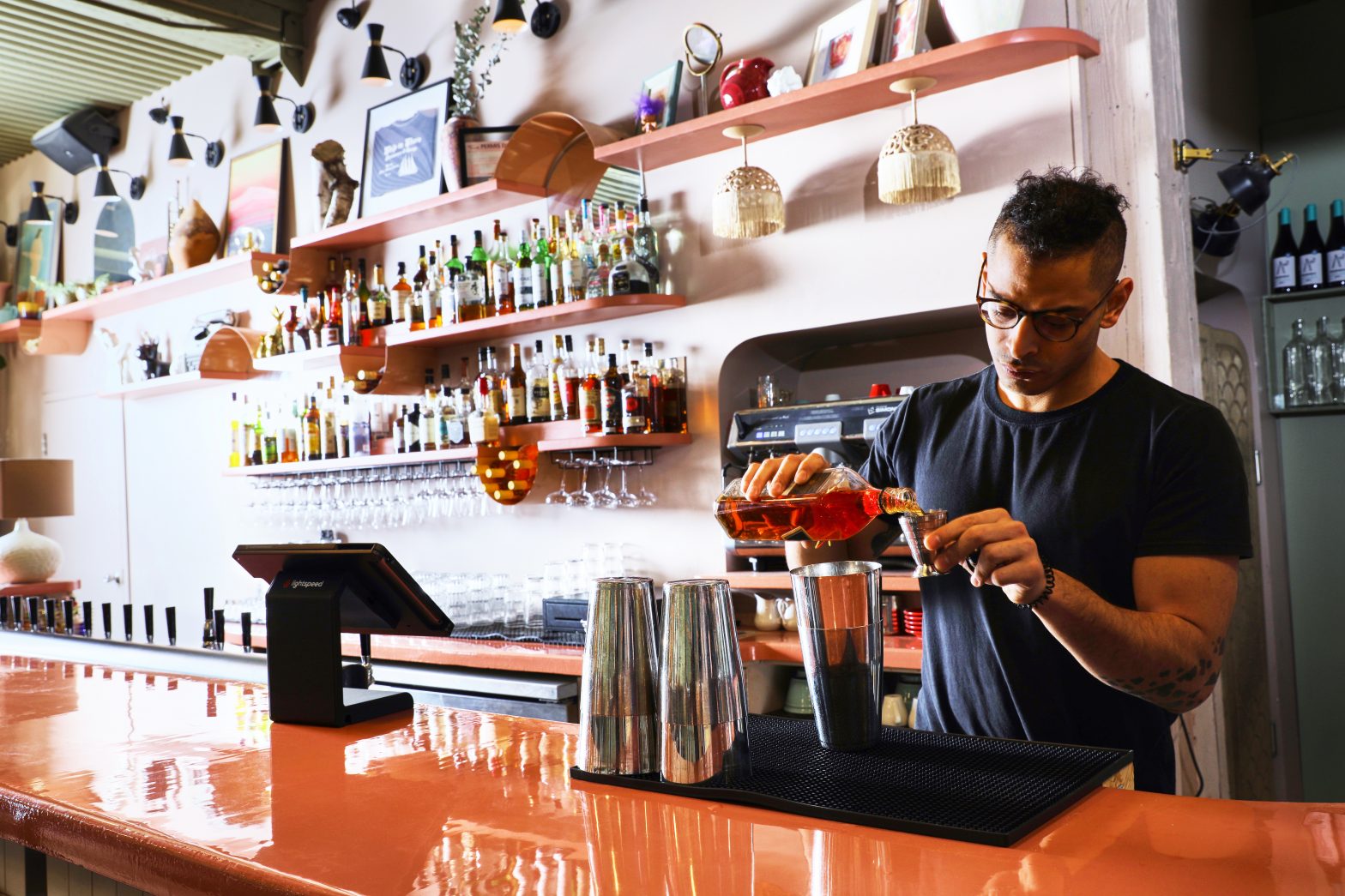
Bartenders may be the ones chatting up customers, taking orders with the point of sale system and making drinks, but there’s another role that’s helping to keep service running smoothly behind the bar—the barback.
So what is a barback and what do they actually do? In this post, we’ll explore what a barback is, what their tasks are, what skills they need to be successful and tips for hiring a great barback.
- What is a barback?
- Barback duties and responsibilities
- How much a barback makes
- Signs you should hire a barback
- How to write a great barback job description
- Hiring a barback
- Training a barback
- What makes a successful barback
- How to know if your barback is ready to become a bartender
Build your restaurant dream team
Employees can make or break a restaurant. Here’s how to attract and hire the best.

What is a barback?
A barback is a bar’s equivalent to a busser. Their role is to ensure that the bartender has everything they need during service to keep everything running smoothly: clean glasses, enough garnishes, liquor, beer and spirits, ice cubes, etc. Similarly to bussers, they’re also responsible for keeping the service area tidy (cleaning up spills and broken glasses) and running to the walk-in to restock whatever’s running low.
And for many, being a barback is the first step to becoming a bartender.
Any way you slice it, barbacks are a crucial part of a high-volume team. Suzannah Gerber, food and beverage industry consultant and owner of Haven Foods, puts it this way: “Barbacks need to keep an eye on inventory levels at all times during service and be aware of the movement and flow of orders and flight path of the bartender.
“They also need to be strong enough to carry heavy items like kegs and be able to repair clogged taps or ice machines at a moment’s notice. A jack-of-all-trades barback can make huge differences in a bar’s service and flow.”
What are a barback’s duties and responsibilities?
A barback handles a long list of tasks on any given day. While a barback’s duties and responsibilities vary in each establishment, there are a few common tasks any barback will likely encounter during any given shift. Here are 23 typical tasks that a barback is expected to take ownership for:
Cleaning tasks
- Keeping the bar top clean and clear of debris
- Wiping down bar stools, removing any that are noticeably stained or need repair
- Clearing dirty glassware from the floor and running it through the dishwasher, or running it to the dish pit and back (once clean)
- Polishing wine glasses
- Helping to run food and clearing plates if the place is slammed
- Taking out the trash and recycling throughout service
- Cleaning up spills and broken glass as necessary
- Clean and organize bottle storage areas and the keg fridge
- Clean no-slip mats behind the bar
- Unclogging sinks
Stocking tasks
- Preparing garnishes and juice mixes
- Sanitizing and refilling ice wells
- Keeping the bar fully stocked with beer, wine and liquor at all times
- Replenishing glasses, toothpicks, napkins, coasters, ice cubes, etc.
- Clearing dirty rags from the bar and restocking with clean rags
- Changing beer kegs, removing empty kegs from the keg fridge and restocking the keg fridge with new, untapped kegs that need to get cold
Opening and closing shift tasks
- Restocking the bar for the following shift
- Putting away shipments of liquor and beer
- Tracking opening and closing inventory levels
Miscellaneous tasks
- Helping the bartender with ad-hoc requests throughout service
- Communicating with security when a guest is acting inappropriately, drinking from a personal bottle, is suspected to be underage, etc.
- Relaying information to and from the bar, kitchen, security, etc.
- In very rare circumstances—for example, during a trial shift on the bar with a very trusting bartender—barbacks may punch orders into the restaurant point of sale

How much do barbacks make?
Now that you know what is a barback, how much do barbacks make?
A barback is typically seen as an entry-level position that aspiring bartenders take on. As such, they’re usually paid minimum wage plus a percentage of tips. Depending on your establishment’s tip out structure, the type of clientele it attracts and how its drinks are priced, that can be anywhere between 1-2% of sales or 5-20% of total tips.
Barback salary
A barback’s salary will vary from country to country and even depending on the state or province where the job is posted.
In the United States however, the average annual barback salary is $27,805 USD, with some states like Massachusetts and Hawaii offering higher salaries, and states like Florida and New Mexico offering lower salaries.
In Canada, the average salary for a barback is $32,760 CAD, with provinces like British Columbia offering above-average pay and provinces like Ontario offering slightly under-average pay.
While a barback’s “official” salary may seem low, they can make serious money working at a busy club, bar or upscale restaurant. It won’t be as much as the bartenders, but as tipped employees, they can potentially earn a lot more than non-tipping positions like line cooks or dishwashers.
For example: let’s say a busy bar has five bartenders working on a night shift. Each of the bartenders will tip out the barback 5% of sales at the end of the shift. They each make $1,000 in sales, which means they each tip out the barback $50. At the end of the night, the barback is walking out with $250 in tips.
Does your bar or restaurant need a barback?
Not all bars and restaurants have barbacks, because not all bars and restaurants need them. It depends on a lot of factors, from your concept to your seating capacity and the level of experience of your staff.
So, how do you know if it’s time to hire a barback (or barbacks) for your bar or restaurant? Don’t worry—there will be signs. For example:
- Your bartenders are always in the weeds. Your bartenders are consistently struggling to keep up with their primary duties—like making drinks and engaging with customers—because they’re spending too much time restocking supplies, cleaning, and handling other tasks a barback could handle.
- Drinks are in the wrong glasses. Wine is going out in rocks glasses and cocktails are being served in pint glasses.—and it’s not part of your concept, it’s because they’re the only clean glasses your bartenders have left.
- The bar is a mess. It’s sticky, there are discarded lime slices and piles of ripped up coasters everywhere—seriously, who raised these people—and empty glasses that haven’t been cleared away because your bartenders don’t have time to keep up with basic bar hygiene. Spills and broken glass aren’t cleaned up within five minutes.
- Everything is 86d. You’ve run out of house red, a bunch of different bottled beers, nobody’s getting a lime slice and your customers can’t order a mojito because the bar’s all out of mint. If your bar is running on empty because there’s no one available to restock, your customers aren’t getting what they want (and you’re missing out on sales).
- Your bartenders are burned out. Your bartenders look and feel like they’ve been through the wringer at the end of the night. Asking them to pick up an extra shift elicits the kind of forlorn whimper you’d expect from the cast of Les Miserables.
- Bar service is really slow. Your servers are camped out at the service bar waiting for their drink orders; customers are getting their appetizers before their drinks and/or you’re fielding a lot of complaints about slow service.
Of course, a lot of factors can affect the speed of service behind the bar. Maybe your bartenders are inexperienced, or they’re new to your establishment and still learning where things are. Maybe you’re short-staffed*, or you just got slammed by a huge crowd from an event nearby that you didn’t know about.
But, if service is slow because your bartenders have to go change a keg, or restock wine, or cut limes, or burn the ice because a glass broke in the ice well, you should definitely consider hiring a barback to ensure smooth and efficient service.
*If you’re struggling with over or understaffing—neither of which is great for your guests or your employees—a point of sale system with Advanced Insights can help you to better forecast your staffing needs and plan accordingly. Integrated with employee scheduling software, you could save yourself a lot of time and labor costs.
Bar 404 saves $400-500/week on labor costs
A seamless Lightspeed x 7shifts’ integration empowered Bar 404 to automate labor-optimized schedules.

How to write a great barback job description
An effective job description—barback or otherwise—generally includes three components: an overview of the role, a curated list of responsibilities and the skills required to perform the job.
Job overview
For the job overview, you’re effectively answering the question “what is a barback?” Provide a brief, three to four-sentence description of the role and what it takes to succeed in it.
Here’s an example:
We’re looking for a hardworking barback to join our team. As a barback, you will support the bartender to maintain a clean and well-stocked bar. You’ll prep and replenish supplies, change kegs, maintain clean and organized beer/wine/liquor storage areas, wipe down and clear the bar top, and other duties as needed.
To succeed in this role, you will need to be able to lift full kegs (~160-lbs), be a team player, be able to adapt to changing priorities and work well under pressure.
Responsibilities
A barback handles a long list of tasks on any given day. While a barback’s duties and responsibilities vary in each establishment, there are a few common tasks any barback will likely encounter during any given shift.
Experiencing dejà vu? It’s because we covered 23 typical barback tasks and responsibilities in a previous section. Jump to that section now.
Of course, every establishment has different needs, which means the list of tasks your barback will perform is likely to differ slightly from place to place. When you’re crafting yours, make sure it reflects the duties and responsibilities you, specifically, expect your barback to do.
It’s unlikely that your barback will perform only the tasks that you include in the job description—unless you want it to look like a master’s thesis. To communicate the variable nature of the job, you can add a line like “and other duties as needed” to the list of responsibilities, and be sure to include “ability to adapt and help wherever needed” to the required skills section.
Skills required
A good bar or restaurant manager should be able to assess what skills each of their employees need to possess and communicate that information in the job description.
But to save you some time and effort—because that’s what Lightspeed is all about—here’s a list of required skills you may want to include in your barback job description:
- Physical strength: Putting away shipments of liquor and beer and carrying kegs requires some strength. Your barback needs to be capable of doing some heavy lifting.
- Organization: To be successful, a barback needs to be organized and systematic, while being adaptable enough to anticipate any obstacles that get thrown their way during each and every shift.
- Proactivity: A great barback will be able to take care of tasks before they become urgent. That means restocking bottles, garnishes, etc., before the bartender has to ask.
- Ability to multitask: A successful barback will try to maximize the tasks they take care of in the time they have. For example, if they’re heading to the kitchen, bringing dirty dishes with them to the dish pit at the same time.
- Ability to work under pressure: The service industry is fast-paced. A barback needs to be able to handle the pressure of a busy Saturday night without burning out or losing their cool—especially with guests.
- Ability to prioritize tasks based on urgency: Issues are bound to come up simultaneously. The toilet is clogged and napkins need to be refilled. Which task do they take care of first? Barbacks need to be able to quickly triage tasks and handle them accordingly.
- Adaptability: Christopher Manning, Managing Director or Gastronomer Lifestyle Ltd., says that the ability to adapt is what separates good barbacks from great ones. “When a bar gets hit by the evening rush they must be able to assess and prioritize the tasks at hand. It’s always important to finish each task you start too; don’t leave it for someone else.”
In this required skills section, you may also want to include some nice-to-haves like customer service skills or beer/wine/cocktail knowledge. Most barbacks will learn these on-the-job, but all the better if they have some experience already.
Make sure you clarify that these are nice-to-haves so you don’t scare off less experienced but equally great candidates from applying.
How to hire a barback
Once you’ve written an accurate, descriptive job ad, you need to post your job ad on the right channels for it to be seen by qualified candidates. We suggest starting with these websites:
Along with those job listing websites, post on your Facebook and Instagram accounts that you’re hiring. The people who follow your establishment on social media are your biggest fans. Who knows? Maybe one of them is your next barback, too.
Additionally, let your staff know that you’re looking for a barback. Great people know other great people; leverage your employee’s network of friends to find candidates that have a great chance of being a strong fit. If they need some incentive, consider giving them a referral bonus if the candidate they recommend is hired, performs well in their role and successfully completes their probation period.
Barback training tips

Once you’ve hired your ideal barback, you need to train them so they can reach their full potential. The good news is that training a barback is similar to training any restaurant employee: you need a solid mix of on-the-job learning, formal training and on-the-spot feedback.
Onboarding
First thing’s first, be crystal clear with your new hire about things like your dress code, what is and isn’t acceptable behavior, how they are expected to interact with guests, etc. An employee handbook makes it much easier to get new hires up to speed on the essentials of working at your establishment (like procedures, policies and guidelines).
Environment
Give your new hires a tour of your establishment. Show them where the cleaning products are stored, where clean and dirty utensils go, where the liquor cellar is and where the dish pit is—you get the idea. Show them where all the things they may need during a shift are located so that they can be more proactive once service starts.
Shadowing
Nothing can replace learning from someone who’s been there and done that. Before giving your barback full autonomy, have them do a walkthrough of their tasks and how and when to do them with one of your senior barbacks or your bartender.
When they learn the ropes and have the safety net of experienced supervision, they’re less likely to make mistakes when they’re on their own and can build their confidence more quickly.
Plus, shadowing is great for team building. It gives your new hire an opportunity to bond with co-workers, learn their names, what they do and how they fit into your existing team dynamic. They can also get a crash course on restaurant terms so they know what you mean when you tell them to go clear the glasses off the 4-top with the campers.
Menu education
This is less important at the beginning of your barback’s tenure, but if they’re hoping to move up to bartender one day, they’ll need to learn your drinks menu, how each drink is made, what their flavor profiles are and what dishes they complement. The sooner they learn these things, the better.
Have your bartender give the barback a crash course on the cocktail menu so that they learn the basics and feel encouraged to ask questions. The more information your bartender passes on to the barback, the more useful their trusty sidekick will be.
What makes a successful barback
Due to the fast-paced nature of the job, a barback needs to be ready to think on the spot and be ready for different tasks at a moment’s notice. To succeed in their role and make their way towards becoming a bartender, these are some tips barbacks should keep in mind.
Open to learn
Restaurant and bar hours are long, hectic and heated, so the first few weeks might take a bit of a toll. A barback needs to be patient and open to learning when starting the job. A barback should be ready to ask questions, take their training seriously and be ready to switch tasks on the spot.
Head on a swivel
Kitchens and bars can be a dangerous place. A barback will be constantly running back and forth between the FOH and BOH, and going from table to table and back to the bar. In these environments, it’s really important to be aware of your surroundings. Barbacks need to get to know the space quickly and stay on the lookout for customers or other staff.
Bars are also usually tight spaces, filled with other barbacks or bartenders. It’s key for a barback to understand how their coworkers work, recognize and correct when they’re in the way and move with stealth.
Methodical with inventory
One of the most important tasks for a barback is restocking inventory. Shifts are notoriously hectic, and this means that bottles, garnishes, drinks mixers and other products can get used up quickly. It’s up to the barback to ensure that inventory is constantly replenished.
In many establishments, the bartenders are responsible for taking inventory counts at the start and end of their shift. In others, it’s the barback. Either way, a barback who can support the bartender with accurate inventory counts is a barback with a bright future in the industry. While some places still depend on manual inventory processes, barbacks should also be ready to learn how to use an automated inventory management system.
Integrated with a restaurant point of sale, an automated system eliminates manual stock counts and spreadsheets, allowing staff to view current stock and benefit from real-time deductions and replenishments when inventory is used or received.
How to know when your barback is ready to become a bartender
For many, being a barback is a stepping stone to becoming a bartender full time. While there’s no exact timeline for a barback to become a bartender, in most establishments it can take between 12 to 16 months. That’s usually enough time for a barback to learn the ropes from your bartender, get comfortable with the cocktail menu and your clientele.
Even once you think they’re ready to take the next step (and they’ve shown interest in becoming a bartender) you should plan a transition period where the barback shadows the lead bartender more intently and starts serving customers during slower shifts where they’re less likely to get overwhelmed. This also gives you time to hire a new barback to take their place.
Even if the legal drinking age in the US is 21, bartenders can be under the legal drinking age depending on the state’s on-premise alcohol serving laws. While some states allow underagers to serve alcohol, others require that they be 21 and over, have a manager or supervisor over 21 present or that an underage bartender or barback complete beverage service training. Bottom line: make sure your barback has the necessary licenses and permits and meets your state’s alcohol service laws before making it official.
Finding the barback that’s right for you

Knowing what to look out for is key in finding a barback, but even more important is finding a barback that works well with your team. Working in the restaurant and bar industry means busy and hectic nights, working in close quarters, in a potentially high tension environment. Fostering good chemistry with your team can be the difference between success and failure with your new hire.
A barback can tick all the boxes, but if the chemistry isn’t there with the team, this will affect your service and eventually your customer experience. So during your search, prioritize the unteachable intangibles: work ethic and attitude. Ideally, you want someone who has both of those and possesses all the skills and attributes we mentioned earlier, but while you can teach skills, you can’t teach attitude.
Looking for a bar point of sale system that your staff will love? Talk to one of our experts to find out how Lightspeed can help.
FAQs
What is a barback and what do they do?
A barback is an important support staff member in a busy bar, nightclub, pub or restaurant. They are responsible for helping bartenders ensure the bar operates smoothly. Typical duties of a barback include restocking supplies, cleaning glassware, replenishing ice, preparing garnishes and maintaining a clean and organized bar area.
What are the essential skills of a good barback?
A good barback possesses several key skills and attributes, including organization, teamwork, adaptability, physical strength (to lift kegs up to 160 pounds) and stamina (to handle long shifts in a fast-paced environment). Excellent communication skills and a proactive attitude are also important.
How does a barback contribute to a bar’s success?
If you’ve ever asked yourself “what is a barback?”, they are the unsung heroes who keep the bar running smoothly behind the scenes. Barbacks play a vital role in a bar’s success by keeping the bar stocked, clean and organized so that bartenders can focus on serving customers.
What training or experience is needed to become a barback?
While formal training is generally not required to get hired as a barback, candidates with experience in the hospitality industry will have a competitive edge over candidates who don’t. Most skills are learned on the job, but a good understanding of bar operations and a willingness to learn are crucial.

News you care about. Tips you can use.
Everything your business needs to grow, delivered straight to your inbox.


